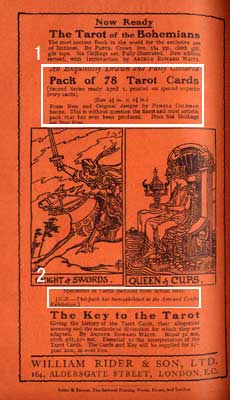 |
 |
 |
| Rider Waite Smith Tarot Adverts in The Occult Review. |
| by Koretaka Eguchi last updated in 12th June, 2018. *** First I would like to express deep gratitudes and respect to Mr K. Frank Jensen who gave us the basic knowledge and infomation of the early Rider Waite Smith Tarot. *** |
As I wrote everywhere, recently I could collect 80% of all the issues of The Occult Review. And by checking them one by one I could find some important info about the early RWS Tarot decks. First of all, the editor of the magazine Sir Rallph Shirley wrote in the " Notes of the Month" as follows: |
| I have the pleasure to announce to my readers the forthcoming publication
of a new pack of Tarot Cards, an illustrated notice of which under the
title of the Tarot; a Wheel of Fortune, by Mr A.E.Waite, appears in the
current number of this magazine. the Cards will, I anticipate, be ready
for sale by about December 10. These can be better judged by the illustrations
which go with the article in this issue than by any description I can give
them.* It will, however, be apparent that they are of a far higher quality
in respect of artistic merit than any pack which has hetherto been published.
The Cards in their published form will be fully coloured. the lithographing
process has been undertaken by Messers. Sprague & Co., whose name is
sufficient guarantee for the excellence of the work. Simultaneously with
the issue of these Cards there will be published a book entitled The Key To the Tarot, to be sold in a case along with the pack for 7s. post free. *I may mention that the artist, Miss Colman Smith, made a careful examination of numerous tarot packs from the 14th century onwards before undertaking her work. |
| The Occult Review 1909 December 300-301pp |
| So the first decks were printed lithographically by Sprague & Co. That is a well-known fact and no need to repeat it here. The Waite arcticle "Tarot : a Wheel of Fortune" can be read in recent reprinting. I believe the following advertisement found in the backcover of 1910 April issue is really important one, a sort of "missing link" in the study of early RWS editions. |
 |
 |
 |
| Of course, the important parts are "Second Series ready April I, printed
on special superior ivory cards" and "This pack has been exhibited at the Arts and Crafts Exhibition" (my emphasis). Second series were printed on ivory cards, well then
the First series on what? and judging from the context, the first series
were exhibited at the Arts and Crafts Exhibition. All these taken into consideration, my understanding is that the first series of RWS was "Roses & Lilies" backpattern decks and they were a sort of special version to be sent to the Arts and Crafts Exhibition. Probably the number of the actual decks were small and quickly sold out. Then William Rider & Son Ltd. printed the second series, the ivory-pebbled ones as a standard model. I believe this is the answer. Another reason William Rider & Son printed the second series was that the card quality of the R&L packs was not good and some cards began peeling off. In a word, the very first RWS was the R&L packs of 1909, but they were
practically cancelled decks due to the inadequate quality of cardstock
and dull coloring. William Rider printed the second series in April 1910,
and proposed a replacement of a pack to the customers who had purchased
R&L ones. This is the reason the R&L packs are so rare now.
|
| The above backcover adverts came back again in the December issue of OR 1910, but without the [Second...ivory cards] part. |
An interesing advertisement is found in the November issue of OR 1912, as it goes : |
| A PACK OF 78 TAROT CARDS : Exquisitely drawn and coloured, from new and original designs by PAMELA COLEMAN SMITH. Each card has a separate allegorical meaning. This is without question the finest and most artistic pack that has ever been produced. Price 6s. net, in neat blue box, post free. "The most wonderful pack of cards that has ever been seen since the days when Gringonneur illuminated three packs for the amusement of King Charles VI. of France, in the year of our Lord 1392." -- Arthur Machen in T.P.'s Weekly. |
| THE KEY TO THE TAROT: Giving the history of the Tarot Cards, their allegorical meaning and the methods of divination for which they are adapted. By Arthur Edward Waite. Royal 32mo, cloth, gilt, 2s. net. Essential to the interpretation of the Tarot Cards. The Cards and Key are supplied together in neat red box for 8s. post free. "An interesting account of the mysterious symbolism of the cards -- The Scotsman. |
| Where are the original drawings now? PCS gave us a clue as to the whereabout of the original drawings of 1909 Tarot project in the famous "Stieglitz letter". "I have just finished a big job for very little cash! A set of designs for a pack of Tarot cards 80 designs. I shall send some over - of the original drawings as some people may like them! I will send you a pack (printed in color by lithography) ? (possibly very badly!) as soon as they are ready ? by Dec 1 - I think." So we can safely assume that some of them were sent to New York and consequently listed for sale. At least we found six Tarot drawings in the PCS 1912 exhibition held by Berlin Photographic Company in New York. Were those six drawings "unsold ones" of the original 80? Or did PCS keep most of them for future sale or for her personal collection? We are not sure. Anyway the original drawings are missing and an extensive research are nessesary, especially around New York area. |
 |
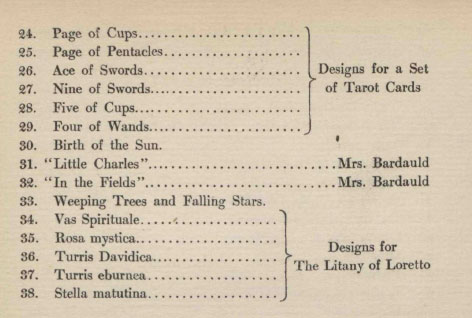 |
|
|
The authorship of the RWS calligraphy
| It seems some people have a doubt about the authorship of RWS calligraphy ; those letters of card titles were perhaps not done by Pamela Colman Smith. I don't know what kind of proof make them think so. By comparing PCS's calligraphy shown in other works, we can sufficeintly convince ourselves that it was her work. The below (1) is taken from RWS The Queen of Sword. (2) is from the front cover of Blue Beard (1913), and the (3) is from Ace of Swords. Compare RD of (1) and (2), and "A" and "E" of (2) and (3). | |
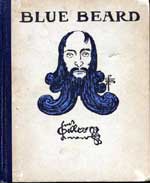 Blue Beard (1913) |
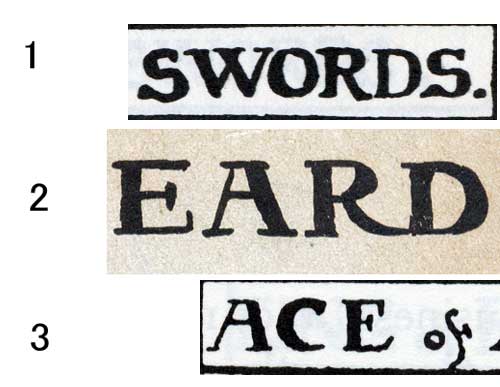 |
And I would like to show a bookplate designed by PCS as a subsidiary proof. Each word has a period (full stop) at the end, as the most of RWS trumps and court cards do. |
|
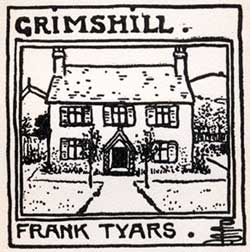 |
|
List of RWS Advertisements in The Occult Review 1909-1948.
| The following list is not complete because my collection of The Occult Review is incomplete. I have yet to collect many issues published before 1920. And the bound volumes of 1921-1948 are often lack of front and end advertisement pages. |
| Example of Cover Ads. | 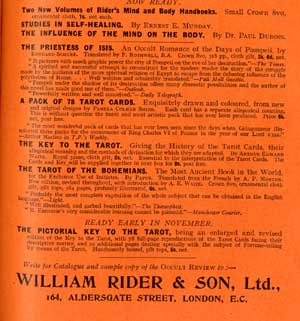 |
|
|
|
| Example of Line Ads. | 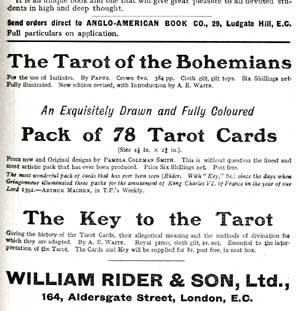 |
|
|
|
| Example of Square Ads. | 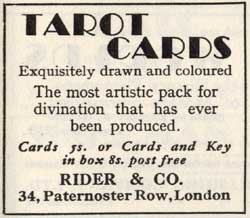 |
| A. .. the Article "The Tarot; A Wheel of Fortune" by Arthur Edward Waite, with 13 drawings of Pamela Colman Smith. C ... Cover Advertisement. L ... Line Advertisement. S ... Square Advertisement. |
|
| 1 | 2 | 3 | 4 | 5 | 6 | 7 | 8 | 9 | 10 | 11 | 12 | |
| 1909 | A | |||||||||||
| 1910 | C | L | C | C | ||||||||
| 1911 | ||||||||||||
| 1912 | L | L | ||||||||||
| 1913 | L | |||||||||||
| 1914 | ||||||||||||
| 1915 | L | L | C | |||||||||
| 1916 | C | |||||||||||
| 1917 | L | |||||||||||
| 1918 | ||||||||||||
| 1919 | ||||||||||||
| 1920 | L | |||||||||||
| 1921 | L | |||||||||||
| 1922 | ||||||||||||
| 1923 | ||||||||||||
| 1924 | ||||||||||||
| 1925 | ||||||||||||
| 1926 | ||||||||||||
| 1927 | ||||||||||||
| 1928 | L | |||||||||||
| 1929 | ||||||||||||
| 1930 | ||||||||||||
| 1931 | ||||||||||||
| 1932 | L | S | ||||||||||
| 1933 | S | S | S | |||||||||
| 1934 | S | S | S | S | S | S | S | S | S | S | S | S |
| 1935 | S | S | S | S | S | S | S | S | ||||
| 1936 | ||||||||||||
| 1937 | ||||||||||||
| 1938 | ||||||||||||
| 1939 | L | |||||||||||
| 1940 | ||||||||||||
| 1941 | ||||||||||||
| 1942 | ||||||||||||
| 1943 | ||||||||||||
| 1944 | ||||||||||||
| 1946 | ||||||||||||
| 1947 | ||||||||||||
| 1948 |
Address of Rider & Co.
| The following is the list of addresses of Rider & Co. found in The Occult Review 1905-1948. After that, the addresses are those found in several books published by Rider & Co. I believe the informaiton might be valuable in some cases of date ID of packs or books. |
| William Rider & Son, Ltd. 1905. 164 Aldersgate Street, London, E.C. 1912 October Cathedral House, Paternoster Row, London, E.C. Rider & Co. 1925 July. 33-36 Paternoster Row, London, E.C. 1925 September Paternoster House, London, E.C. 1941 April, 47 Princess Gate, London, S.W.7. 1944 July 37 Bedford Square, London, W.C.1. 1945. January. 68 Fleet Street, London, E.C.4. 1948 Winter. Bouverie House, Fleet Street, London, E.C.4. 1948 Spring. 47 Princess Gate, London, S.W.7. 1953 from Frank Lind My Occult Case Book. Hutchinson House, Stratford Place, London, W.1. 1974 from The Pictorial Key to the Tarot (second edition, second impression). 3 Fitzroy Square, London, W.1. 1986 from the LWB of Royal Blue Rider Tarot (ISBN0-09-109340-6) 20 Vauxhall Bridge Road, London, SW1V 2SA, |